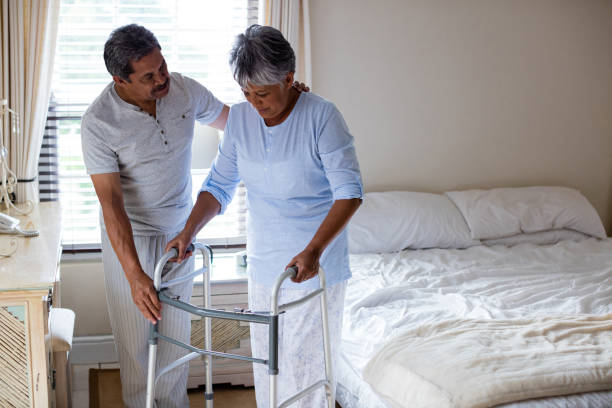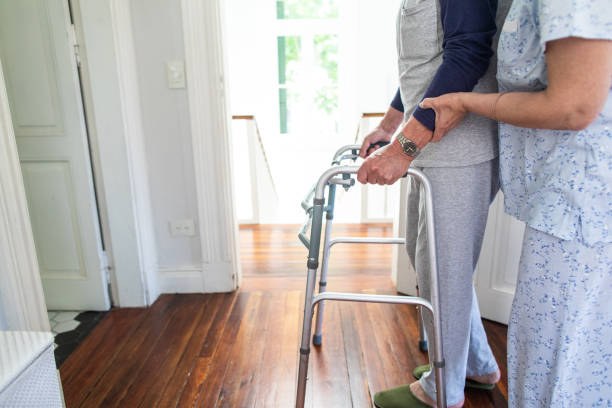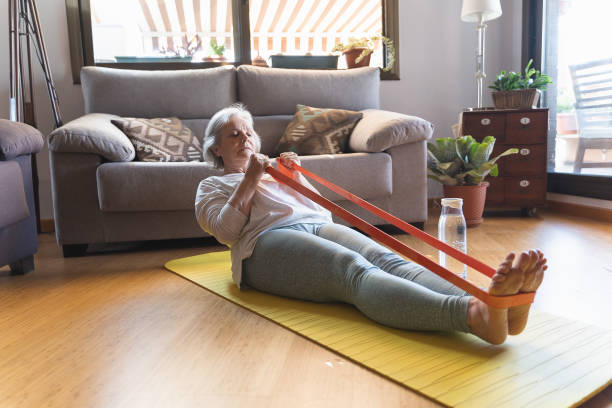Introduction

Are you or someone you know struggling to stay balanced or maintain proper posture while moving in bed with Parkinson's? Falls, stooped postures, and general imbalances are common struggles associated with this condition. Poor balance can significantly reduce the quality of life, making it important to find strategies that help prevent falls and improve the ability to move safely in bed.
In this blog post, we'll discuss some evidence-based strategies that act as a starting point for managing movements in bed with Parkinson's. We'll focus on how safety is paramount when avoiding falls and maintaining balance while moving in bed and discuss ways to prolong independence over time through preventive measures like exercise and positioning techniques. So let's get started!
Falls and Common Household Hazards
If you or a loved one has Parkinson's disease, here are tips for preventing falls around the home:
Floors: Keep all floors clear of objects and clutter. Place a non-slip rug or mat near the bed, chair, and other places you may need to stand.
Lighting:
-
Make sure hallways are well-lit.
-
Install night lights throughout the house, including the bedroom and bathroom.
-
Consider using motion-sensor-activated lights that turn on when you enter a room.
Staircases:
Install handrails on both sides of the staircase and consider installing non-slip treads on the stairs. Keep them free of objects or debris at all times.
Furniture:
Place furniture away from pathways so it won't be an obstacle when moving around the house.
Doors:
Ensure all doors open outward, away from you, to prevent tripping and falling.
Bathrooms:
Install grab bars in the bathroom near the toilet and around the bathtub or shower stall for added stability when transferring in and out of them. Consider using a shower chair with a backrest for extra security.
Ramps:
Install a ramp if you have any steps leading to your home's front or rear entrance.
Freezing of Gait
Another symptom of Parkinson's disease is freezing of gait (FoG). Freezing of gait can cause difficulty initiating walking, shuffling, or short episodes where the patient stops mid-stride. During these episodes, patients often start taking small steps with their feet close together to avoid tripping and falling.
This can also lead to an increased risk of falls, and it is important to have strategies to prevent this from happening.
One strategy for preventing falls related to FoG is using cues. Cues help cue the patient's brain into initiating movement, which can help with walking initiation and reduce the frequency of freezing episodes. Examples of cues include verbal prompts such as "step" or "go ahead" or physical cues like tapping on the shoulder to help promote movement.
Another strategy for preventing falls related to FoG is creating a safe environment. The patient must eliminate any environmental hazards that could lead to a fall.
Trouble With Turning and Repositioning
When moving in bed with Parkinson's Disease, one of the greatest challenges is turning or repositioning from one side to another. This can be difficult due to impaired balance and coordination as well as weakened leg muscles. With careful preparation and practice, however, it is possible for a person with Parkinson's to safely turn in bed. Here are some strategies to help prevent falls and maintain balance while moving in bed:
1. Before moving, adjust pillows and other items to ensure they do not interfere with the movement.
2. When turning in bed, move slowly and deliberately. Use your arms for support whenever necessary, placing one hand on the bed while you turn onto the other side.
3. Take the effort out of moving in bed by virtually eliminating friction that resists every movement. Friction-reducing sheets and sleep garments are designed to make moving in bed, including getting in and out, considerably easier.
4. Consider using a transfer board or sliding sheet if you need assistance moving from one horizontal surface to another. This can be especially helpful when getting into or out of bed.
5. Practice static balance activities such as standing on one foot, wall push-ups, and leg lifts to improve overall balance and coordination.
Following these strategies can help make turning and repositioning in bed easier for those with Parkinson's disease, which is essential for maintaining safety and independence.
With the right preparation, support, and practice, individuals with Parkinson's disease can remain mobile and independent.
Balance and the Brain
The brain plays a crucial role in balance. As Parkinson's Disease progresses, the parts of the brain responsible for normal movement and balance become impaired. Therefore, strategies to help improve stability while moving in bed should be part of any plan to manage PD.
Dr. Horak has used brain-imaging techniques in her lab to study the effects of movement on balance, and she has identified several strategies that can be used to help people with PD maintain their balance while moving in bed.
The Route to Better Walking
The good news for people with PD is that there are strategies to help prevent falls and improve balance while moving in bed. Start by creating a plan with your doctor or physical therapist to improve your walking. This plan should include exercises that help to strengthen muscles, increase the range of motion, and improve coordination. Additionally, ask for tips on how to reduce the risk of falls.
It is also important to understand how Parkinson's disease affects your gait. Tremors and rigidity can affect how you move, so awareness of these issues when walking is key. A physical therapist or movement disorder specialist can help assess your symptoms and create a tailored exercise plan.
Tricks that can help overcome freezing:
-
Walk to a rhythm: Adding a specific rhythm to your walking pattern can help you get back in motion if you experience freezing.
-
Try focusing on an object or wall: Keeping your eyes focused on an object in the distance can help with balance and getting unit.
-
Be mindful of how you move: Being conscious of your walking movements can help ensure that all body parts work together.
-
Practice: Regular practice of these strategies can help you become more comfortable and confident when moving in bed.
-
If you experience frequent falls, it is important to consider using devices such as a walker or cane for extra support. Adding features like grab bars or raised toilet seats in the bedroom can provide extra stability. With the right strategies and techniques, you can improve your mobility while moving in bed with Parkinson's disease.
Strategies to Prevent Falls - Motor and Nonmotor Symptoms
The primary motor symptoms of PD, such as impaired balance, can make it difficult for people with Parkinson's to move around safely in bed. To prevent falls and improve balance while moving in bed, there are several strategies that people with PD should consider.
Nonmotor symptoms like sleep disturbances, depression, and fatigue can also increase the risk of falling. It is important to address these nonmotor symptoms to minimize the risk of falling.
Strategies for Improved Balance
1. Avoid standing from a sitting position without support, and move slowly when changing positions.
2. Use a gait belt or other assistive device (walker, cane) for support when mobilizing.
3. Utilize handrails or a support bar on the side of the bed, if available.
4. Consider using a full-length, non-slip mat to help reduce slipping.
5. Make sure you are wearing comfortable clothing that won't hinder movement and will stay in place while moving around in bed.
6. Use assistive devices to help you move around in bed, such as a sliding board or the Lift-Mate Bed Transfer device.
7. Practice exercises designed to improve balance, like Tai Chi or yoga.
8. Ask your doctor about physical therapy and medications to help with balance issues.
Tips for Maintaining Balance with Parkinson's Disease

Keep at least one hand free at all times to help you maintain balance and prevent falls. When transferring from bed to a chair or wheelchair, move slowly and use your arms for support. Ensure that the chair's wheels are locked in place before getting up.
Practice regularly standing up from a sitting position without using your hands for assistance; this builds leg strength and helps improve balance.
When getting out of bed, use the side rail as a support and move slowly. Stay in one position for a few seconds before making your next move.
When lying down, sit on the edge of the bed first, then slowly turn and lie down. Use pillows to cushion any turns or transfers so you don't strain your body.
Try to keep your bedroom free from clutter and obstacles that could lead to a fall, such as cords or throw rugs.
Be sure to wear supportive shoes with good traction when getting up in the morning or going to bed at night. This will help reduce your risk of slipping, tripping, or falling.
Talk to your doctor about using adaptive equipment that can help improve balance and reduce your risk of falls, such as walkers, cane, or braces.
Do exercises to strengthen your legs and arms; this will help you maintain better balance and reduce your chance of falling.
Follow a healthy diet and stay hydrated; this will help your body stay strong and improve balance.
Stay active; regular physical activity can help reduce the risk of falls while improving balance and overall health.
Finally, talk to your doctor about any medications that may affect your balance or increase the risk of falls. If necessary, discuss alternatives that may be better suited for you.
Following these strategies can help reduce your risk of falls and improve your balance while moving in bed with Parkinson's disease. If you have any questions or concerns, please speak with your doctor.
Prevent Falls and Maintain Balance with Parkinson's Disease

-
Always use the bed rails to help you move in the right direction.
-
Identify areas of weakness by assessing your current balance and mobility capabilities.
-
Take your time, and don't rush when getting up or lying down.
-
Practice safe moving techniques, such as using the assisted pivot transfer to move easily in bed.
-
Lie down side first, then turn over onto your back.
-
Strengthen core muscles using appropriate exercises, such as abdominal crunches and planks.
-
To alleviate pressure on your hips, position a pillow between your knees when lying on your side.
-
Practice balance exercises while sitting upright on the edge of the bed
-
Utilize assistive devices that provide extra stability, such as grab bars or bed rails.
-
Implement proper body mechanics while transferring in or out of bed, like keeping a wide support base.
-
Stretch regularly throughout the day to improve flexibility.
FAQs
How can you prevent falling for Parkinson's disease?
People with Parkinson's disease can reduce their risk for falls by using strategies to improve balance and coordination. These include performing regular exercises and wearing comfortable shoes that provide the following:
-
Good support.
-
Avoiding slippery surfaces or walking on uneven ground.
-
Ensuring that all items around the bed are within easy reach.
How can I help improve balance with Parkinson's disease?
Exercises that focus on core strength, balance, and flexibility can help people with Parkinson's disease improve their balance and coordination. When selecting an exercise program, it is best to consult a physical or occupational therapist. Simple exercises such as taking short walks or stretching can also be beneficial. Finally, ensure adequate rest periods between activities to prevent fatigue.
What strategies can I use to improve safety and moving in bed with Parkinson's disease?
Strategies for improving mobility in bed include using friction-reducing sheets and sleep garments which together make moving significantly easier, a bedside commode or portable urinal, performing range of motion exercises, side-lying stretching, and rocking in bed to change positions if friction-reducing sheets and sleepwear are not readily available. In addition, regular physical activity and stretching can help maintain strength and flexibility so that mobility is easier when getting in and out of bed.
How do you get in and out of bed with Parkinson's disease?
When getting in and out of bed with Parkinson's disease, it is important to use strategies focusing on safety, balance, and mobility. To get in and out of bed, start by sitting on the edge of the bed before standing up. Have someone nearby to help if needed. When getting into bed, use the side-lying technique to roll onto your back:
-
Sit on the edge of the bed.
-
Turn onto your side.
-
Bring both knees towards your chest.
-
Roll onto your back.
To get out of bed, use the same technique in reverse. To make it easier to get in and out, and to turn in bed use friction-reducing sheets and sleepwear. These are designed to enhance movement with less effort and struggle.
Conclusion
Everyone with Parkinson's disease has unique needs and abilities, so finding a plan that works for you is essential. You may consider incorporating strategies like focusing on proper positioning and good form while moving to prevent falls or improve balance; consulting with your doctor or physical therapist about exercise, assistive devices, and mobility assistance equipment; and taking medications as prescribed to manage motor symptoms. Above all else, stay focused on what makes you feel the best - so you can keep your life enjoyable, carefree, and safe.

